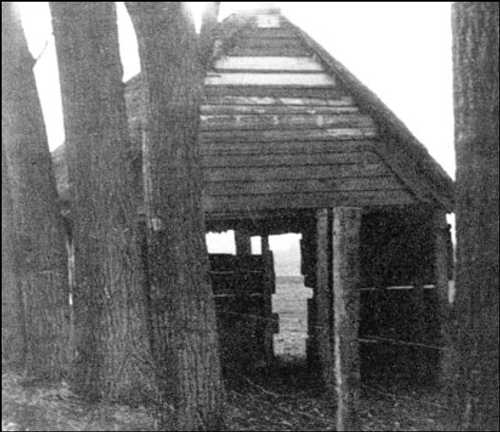
German Forces
Death at Wormhoudt (1).
Unknown private author.
1940 photo of the barn at Wormhoudt, to which some 100 prisoners of war of the British 48th Division and a number of French troops were herded on 28 May, 1940. The Allied soldiers had resisted the German advance in this area with determination, pursuant to their orders to cover the withdrawal of British and French forces towards Dunkirk. This action was not untypical of the deployment and performance of British Army regular units at this stage of the Battle of France. Having fought until their ammunition was exhausted, the British and their French comrades surrendered. It was, perhaps, their misfortune that they surrendered to members of the 1st SS Division, Leibstandarte SS Adolf Hitler (LSSAH), who appear to have been particularly annoyed by their resistance and the delay and casualties caused thereby. The LSSAH men packed close to 100 men into this small barn, and attempted to kill them, first, by throwing hand grenades among them. This was foiled by the bravery of British sergeants Stanley Poole and CSM Augustus Jennings, who threw themselves on the grenades to shield their comrades. Getting fed up with this, the Waffen-SS men turned to open fire into the barn. Some 80 British and French PoWs were killed. As with the "Totenkopf's" Le Paradis massacre of PoWs, the LSSAH men seem to have underestimated the ability of the human body to survive this sort of treatment. A number of the PoWs managed, simply, to run away, while others who were left for dead survived. These men, in one way or another, ended up in German prisoner-of-war camps and survived the war. One would have thought that, as with Le Paradis, this messy massacre would have had legal consequences after the war. As it turned out - no. Attempts at postwar prosecutions descended into confusion. Some postwar testimony suggested that 2 Battalion, LSSAH, commanded at the time by Hauptsturmfuhrer Wilhelm Mohnke ("Hitler's last fighting general") was specifically responsible for this massacre. Mohnke denied that he had issued any order to kill prisoners, a claim that could not be tested at the time because he was in Soviet captivity (and possibly co-operating in supplying information to the Soviets - he was released as part of the 1955 amnesty). Other potential witnesses from the German sider refused to co-operate with investigators. In the end, investigations of the matter by Allied and West German prosecutors were dropped due to lack of evidence. The victims were no less dead. In sadness, JR.
2646 Views
1/16/2015
